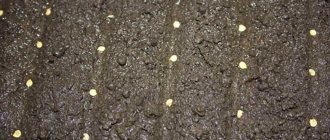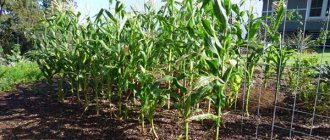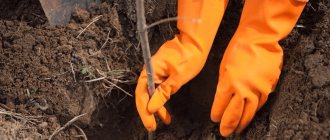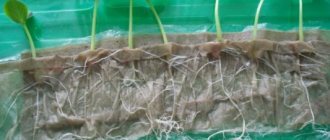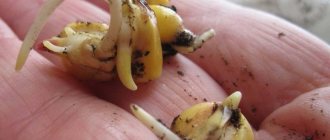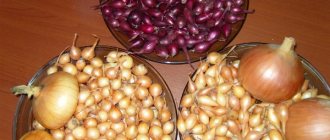Bean varieties for growing in the country
Beans have several varieties according to the method of bush formation:
- bush - a low-growing plant up to half a meter tall;
- semi-curly up to 2 meters;
- curly - from 2 to 5 meters or more.
It should be noted that in the climatic zones of our country, bean vines rarely have time to grow up to 5 meters.
According to the characteristics of the fruit:
- grain - unripe beans have an unpleasant taste, and ripening is characterized by keratinization of the pod and complete hardening of the beans;
- semi-sugar - can be eaten together with the pod until it becomes keratinized, after which it looks and is used like a grain;
- sugar - also called asparagus or vegetable - the pod is not covered with a hard waxy coating, can be used as food along with beans, frozen and preserved whole.
Bush and climbing shelled beans most often belong to determinate varieties - the pods form on the bush and ripen once per season, then the plant becomes useless.
Sugar and semi-sugar varieties are mostly indeterminate - ovaries are formed on them throughout the entire growing season, and these plants do not know dormant periods.
Grain (shelling) varieties of beans
They are good because they are easily suitable for cultivation throughout almost the entire territory of Russia. Hulled beans can be stored for a very long time.
Chocolate - early ripening, heat-resistant, brown beans, medium-sized.
Yin and Yang is a high-yielding bush variety of medium ripening with small round black and white beans.
Pioneer is a fairly old bush variety with rounded white beans, decorated with scarlet patches, of medium early ripening.
Gribovskaya - medium ripening with pods up to 15 centimeters long and white elongated beans, suitable for cultivation in Siberia and the Urals.
A housewife's dream is also unpretentious and has large white beans.
Varieties of sugar (vegetable, asparagus or green) beans
Crane is a bush up to 50 centimeters high, hardy and unpretentious, the pods are round and tender, good for canning and freezing.
Purple Queen is a semi-climbing variety with purple pods and beans; it is distinguished by high yield and excellent taste.
Golden Nectar - a semi-climbing early variety ripens in 70 days, yellow pods reach 25 centimeters.
Sweet courage is an extra-early bush variety with yellow pods up to 20 centimeters long.
The winner is a very capricious, heat-loving variety, decorative during the flowering period, the pods are flat up to 30 centimeters.
Varieties of semi-sugar beans
Liana is a mid-early semi-climbing bean with green pods 20-25 centimeters long.
Secunda is an early-ripening, semi-climbing variety with golden pods up to 12 centimeters long.
Indiana - mid-early variety is distinguished by medium-sized white and red beans.
Macaretti is an early, unpretentious cowpea variety of semi-climbing bean, pod length up to 35 centimeters.
Rant is also an early ripening variety, with green pods up to 15 centimeters long.
Pests and diseases
The plants that most often damage the plant are bean weevils, cabbage cutworms and garden cutworms. Cutworms lay eggs on the ground parts of beans, and the larvae that hatch from them begin to devour the greens, flowers and fruits of the plant. The bean kernel is a bug that enters the soil along with the seeds and destroys the beans from the inside.
What is wrong with beans? With poor care and violation of agrotechnical conditions, beans are affected by anthracnose, bacteriosis and viral mosaic. Bacteriosis is dangerous because its pathogens not only cause harm to plants and even lead to their death, but can also remain viable for many years and develop in crop residues and in the soil. Anthracnose manifests itself as brown depressed spots of irregular or round shape on seedlings, the veins on the leaves become brown, the plates turn yellow, holes form on them, and they die. Red, reddish or brown spots appear on the fruits, turning into ulcers as the disease progresses. Mosaic is characterized by the appearance of necrotic spots and discoloration of veins on bean leaves.
Bean processing
When asked how to treat beans against viral mosaic, we sadly answer: nothing. The viral disease cannot be treated, but it can be avoided if you organize proper care for beans, observe crop rotation and take the preparation of seed seriously. As for anthracnose and bacteriosis, proper care plays an equally important role in the fight against these diseases, and you can get rid of diseases by removing and obligatory burning of diseased plants or their affected parts and treating the beans and the area with one percent Bordeaux mixture.
- Eggplant: growing from seeds in the garden
But before you treat the beans with a fungicide, think about whether it would be better to make it a rule to carry out preventive spraying of the beans and the area against fungal diseases? Treatment of beans and the soil around them with Fitosporin is carried out in the spring, when the seedlings reach a height of 12-15 cm, and after harvesting. This measure, if you follow agricultural practices and crop rotation, can make your beans invulnerable.
As for the fight against insects, you can prevent the appearance of cutworms by deep digging the soil on the site in the fall, but if they do appear in the spring, and there are many of them, you will have to treat the beans with a one-percent solution of Bitoxibacillin or a half-percent solution of Gomelin, which are bacterial preparations. You can prevent bean grains from appearing on your site by carefully sorting out the seeds before sowing, soaking them to swell and subjecting them to pre-sowing treatment with boric acid.
Precursors for beans
Beans have a beneficial effect on the soil, enriching it with natural nitrogen. It is the best predecessor for almost all garden crops. She herself is not particularly picky and has a large range of acceptable predecessors:
- physalis, tomatoes, peppers, eggplants, potatoes - nightshades will provide the best conditions for beans;
- carrots, beets and other root vegetables draw nutrients at a greater depth than beans;
- onions, garlic, wild garlic disinfect the soil and consume microelements in modest portions;
- zucchini, cucumbers, and early cabbage are also acceptable as precursors for legumes.
The only contraindication for beans is other legumes. Consecutive planting of them for several years in a row in one place leads to the accumulation of diseases and oversaturation of the soil with nitrogen.
Bean crop rotation should be oriented towards a five-year cycle.
It is good to use bush beans as a compactor for tomatoes or “add” them to corn, planting the grains in one hole at a distance of 5-7 centimeters to make weeding more convenient.
How to process beans before sowing
Proper planting of beans requires preliminary preparation of the seeds before planting. The seed needs to be warmed up; it is better to do this naturally. To do this, it is enough to leave the seeds in the open air at a temperature of about 30 degrees.
If weather conditions do not allow warming up, you can use an electric dryer.
After this, the seeds need to be soaked in warm water for 24 hours.
Landing dates
Sowing of beans begins when the soil warms up to 15 C and the threat of spring frosts has passed. In the south of Russia they traditionally focus on the flowering of chestnuts. In cooler climatic conditions, this period is associated with the flowering time of bird cherry and the appearance of birch catkins.
In warm climates, it is permissible to plant beans at a later date as a repeat crop - late June or early July. Early ripening varieties will have time to harvest before the autumn frosts.
Beans are a self-pollinating crop; planting different varieties close to each other is encouraged.
A large plantation of sugar and semi-sugar beans can be planted in several stages with a break of 10-14 days to extend the harvest time. This will make it more convenient to can the pods in small batches and use fresh legumes for food for as long as possible.
It is more advisable to choose shelling beans for group plantings of the same ripening period so that the harvest can be harvested in one go. Such varieties most often belong to determinate species.
It is believed that climbing beans are not suitable for northern regions, and it is not customary to grow them as seedlings. But if you sow beans in peat pots in a heated greenhouse, then they can subsequently be transferred to open ground without replanting.
Optimal landing time according to the lunar calendar
For several generations of gardeners, the lunar calendar has been used as the main interpreter. After all, when to plant, on what days is it better to replant, and when to do nothing at all in the garden - every lover of this business needs to know.
So, which days are favorable and which are not in 2021 for planting legumes?
March 2021:
- 1 - plants do not germinate for a long time;
- 2, 3, 6, 10 - the harvest will be unimportant;
- 7, 8, 19-24 - the best time for spraying against pests and diseases;
- 25, 26, 29, 30, 31 - it is better not to sow or plant;
- 4, 5, 9, 11, 13, 27, 28, 17, 18 - gain endurance, resistance to various injuries and diseases. It's time to plant.
April:
- 7, 8, 12, 14, 24, 28 - crops give a bountiful harvest;
- 3, 4, 15-17, 20 -22. 30 - rest for plants and gardeners;
- 16, 17, 23 - plants often get sick and produce seeds of low quality;
- 5, 10, 11, 13, 18, 19 - these days ensure a bountiful harvest
May:
- 5, 6, 7, 25, 26 - it’s worth planting seedlings, they will be better accepted;
- 2, 3, 11, 12, 15, 16, 20, 23, 24, 30, 31 - low plant yield;
- 1, 27, 28, 19, 29, 18, 13, 14 - rest for legumes;
- 4, 9, 10, 17 - obtaining large and tasty fruits, resistance to pests and diseases.
June:
- 2, 3, 4, 18, 22-23, 30 - gives an abundant harvest of good quality, which is well stored;
- 1, 5, 6, 13, 17, 19, 26-28 - sowing and planting legumes is possible;
- 8, 12 - sowing and planting trees and shrubs, legumes, grains;
- 9, 10, 11, 14, 15, 16, 24, 25 - plants rest;
- 7, 20, 29 are favorable times for planting.
Choosing a location and preparing the soil for beans
Beans need a fairly bright place; they prefer loose sandy loam soils without stagnant moisture. Drafts are not a problem, but for climbing and semi-climbing varieties tied to supports, the wind can become a problem.
In the south, melon cultivation of shelled beans is often practiced - in open space, poor soil and with poor watering.
But if all the gardener has is six acres of dacha land, then it makes sense to prepare beds for legumes especially:
- In autumn, planting residues are carefully removed;
- the soil is enriched with rotted manure or compost;
- add dolomite flour at the rate of 50-60 grams per square meter;
- also use kemira, ammophos, or any other complex mineral fertilizer according to the instructions;
- then they dig to the depth of a spade bayonet;
- in the spring, wood ash is added - approximately 200 g per square meter;
- re-dig.
Seed preparation
Beans have phenomenal germination - there is no need to stimulate or harden them. An intact bean will germinate in any case.
It makes sense to pre-calibrate the beans, choosing only even, smooth specimens of the same size for planting.
Beans are sown dry or sprouted, depending on how soon they expect to sprout.
Germination of beans occurs in a shallow container between two layers of damp material and takes no more than 3-5 days.
Pre-sprouted beans must be placed in holes with greater care; they will sprout earlier, but are more vulnerable to return frosts and birds feasting on the beds - for some reason they find sprouted beans underground faster.
Planting beans in open ground
Bush beans are planted to a depth of 5 centimeters at intervals of 20-25 centimeters.
When growing melons:
- holes are made with a hoe or a flat cutter in one or two strokes, raking away piles of earth in one direction;
- beans are usually placed in holes with two or three grains;
- piles of earth are raked back to their original place with several movements of the rake;
- watering of sprouted beans is done in small portions directly onto freshly filled holes;
- If the beans are sown dry, then you don’t need to water them.
In garden conditions, you can plant both climbing and bush beans in holes formed with a diameter of 25-30 centimeters or in grooves in two rows, for the convenience of subsequent watering and weeding.
Indeterminate varieties of beans with decorative flowers, such as Blau Hilde, Matilda or Royal Grain, can be planted in a flower bed. They will very quickly braid pergolas and decorate the garden.
Vegetable beans - description of garden crop
The annual herbaceous plant belongs to the legume family. The average height of the plants is 60 cm. The stem forms lateral shoots, the roots with a core structure penetrate to a depth of about 1 m. During the period of active ripening, the beans produce fruits in the form of pods with beans. The leaves of the plant are voluminous, rich green, oval in shape. When flowering, white, pink or purple inflorescences form on the stems. The agricultural technology of beans depends on the variety grown and allows you to obtain pods with beans ranging in size from 6 to 15 cm.
Bean care
Caring for beans includes regular loosening and weeding, watering, fertilizing, sometimes thinning and pruning bushes if necessary.
Determinate bush varieties require minimal attention. It is advisable to fertilize their plantings when the appearance of the plants indicates a lack of nutrition.
You have to tinker with climbing and semi-climbing specimens, since their significant above-ground part needs high-quality and regular nutrition. And a longer growing season is associated with a greater number of problems.
Watering and fertilizing
Water the beans early in the morning or in the evening under the root with settled warm water. To do this, you can fill a large container or tank with water from a well in advance and use the water for irrigation a day later, when it warms up to a temperature approximately equal to the air temperature.
Before budding begins, the beans are watered as needed, alternating moistening with loosening. The soil should remain moist all the time, but water should not stagnate in the garden bed.
When flowers begin to set, watering is temporarily suspended. When the pods set and begin to grow, watering is carried out approximately once a week. And then they gradually stop them completely.
This strategy is not suitable for indeterminate varieties, especially sugar and semi-sugar varieties - they are watered moderately and regularly throughout the growing season.
Fertilizing is applied two to three times per season:
- the first is carried out after the formation of the first pair of true leaves - phosphorus or phosphorus-potassium fertilizers in a solution of 15-20 g per 10 liters of water;
- during the period of mass budding and the beginning of flowering - potash fertilizers (10-15 g per 10 liters) or a solution of wood ash (a glass per 10 liters);
- The third fertilizing with phosphorus-potassium mixtures in a proportion of 10-15 g per 10 liters of water is carried out during the ripening period of the beans.
Nitrogen fertilizers for beans are evil. Additional feeding makes sense only if the bushes are physically lagging behind in development.
Loosening the soil
This is the main procedure for bush beans; it will not harm climbing specimens either. Beans do not like dampness at the roots; they need oxygen circulation. Therefore, the crust of the earth must be constantly broken in between waterings.
When growing melons upland, this procedure replaces watering. The tool for loosening should be selected with a small blade, and the work itself should be carried out carefully, without making deep punctures in the soil, so as not to damage the root.
- The first loosening is associated with weeding and is carried out as soon as the first two leaves appear from under the ground;
- When the bean bushes reach a height of 6-7 centimeters, a second loosening is carried out;
- The third is carried out simultaneously with a small hilling two weeks later;
- Before closing the rows, a final loosening is carried out;
- If the bushes are planted at large intervals, then you can not neglect this procedure in the future.
The hole under the tied bushes is loosened as needed.
Garter beans
Climbing varieties require support, which is wiser to install in advance. A mesh with large cells or a thin vertical support is best. Tie the beans with sparse loops, without pulling the stem. There is no need to attach the bean vine to the support too often; it clings to it very well on its own.
Bush varieties that reach a height of 60 centimeters, such as Flamingo or Shokoladnitsa, also need support. You can plant such plants in one row and, installing two pegs at each end of the row, stretch a circular horizontal support of twine between them. Single bushes can be tied to an individual support by placing a peg nearby and securing the stem to it with a loose loop of fabric.
Is it possible to create conditions suitable for beans at home?
I lived my entire childhood in the Krasnoyarsk Territory (Eastern Siberia), in an apartment on the 5th floor. The most favorite plant for decorating the balcony was the climbing bean, blooming with fiery red flowers. It was sown in standard balcony boxes with a depth and width of about 20 cm and a length of up to 50 cm. 10 beans were placed in two such boxes. This was back in Soviet times, so they didn’t know about any ready-made soils from the store. They collected soil in the yard from a pile brought for flower beds. They didn’t change it in the boxes for years, didn’t feed or fertilize it with anything.
Red flowering beans grow well on the balcony; they do not need a large amount of soil or special care.
The beans grew very actively every year, the vines climbed along the stretched ropes all the way to the canopy of the balcony. All the stems were covered with flowers, and then with pods. Back then it was normal for me. But today I wonder how this heat-loving culture could grow in such Spartan conditions. Maybe it’s true that all its species are so unpretentious that they can grow not only in the garden, but also on the balcony, and even on the windowsill.
Video: experience of growing beans on the balcony
Optimal conditions for bean development:
- The soil is sandy loam or loamy, heated to +12... +15 ⁰C.
- Air temperature: +20… +25 ⁰C.
- Lighting: intense sunlight.
- The length of the day before fruiting begins is 10–12 hours.
The last point needs some explanation; by understanding and applying it, you can get maximum bean yields anywhere. The culture refers to plants with short daylight hours. For the establishment of generative organs, that is, flower buds, 10–12 hours of illumination is required. If you provide your plants with exactly this length of day from the moment of germination to the beginning of flowering, you will receive earlier and more abundant fruiting. During the period when the beans are already making you happy with the harvest, this parameter is not particularly important.
From germination to flowering, it is advisable to keep beans with 10–12 hours of daylight, the lighting should be intense
Collection and storage
Collection and storage of shelled beans
The shelled beans ripen more or less smoothly. Signs of maturity are:
- drying out of the pod;
- color change - green varieties turn yellow, purple and red ones become paler, lose their waxy shine;
- the mature pod begins to rattle;
- peels easily and the beans become strong.
The beans are removed from the garden in several stages, collecting the dried pods and leaving the green ones to ripen. The collected pods are dried for some time, spread out in a thin layer in a well-ventilated area. Then they start peeling.
This can be done manually, splitting each pod separately. But well-dried pods can be placed in a bag and crushed or beaten with a rolling pin. This will not cause any harm to the beans. When most of the pods have split, they are poured into a large cup and the beans are separated from the husks.
Beans can be stored for years in tightly closed containers at room temperature.
Unshelled beans cannot be stored - the pods accumulate moisture and serve as a breeding ground for pests and diseases.
Harvesting sugar and semi-sugar varieties
Green pods are considered edible when they are sufficiently plump and shaped. They can be collected for frozen preservation and eaten.
Harvesting green beans should be done every other day. If you do this less often, the pods will overripe and prevent the development of new ones. You need to separate the pod from the stem with scissors without disturbing the plant. If all conditions are met, the bush will bear fruit until the end of the season.
Overripe semi-sugar varieties are collected and stored in the same way as shelled varieties.
